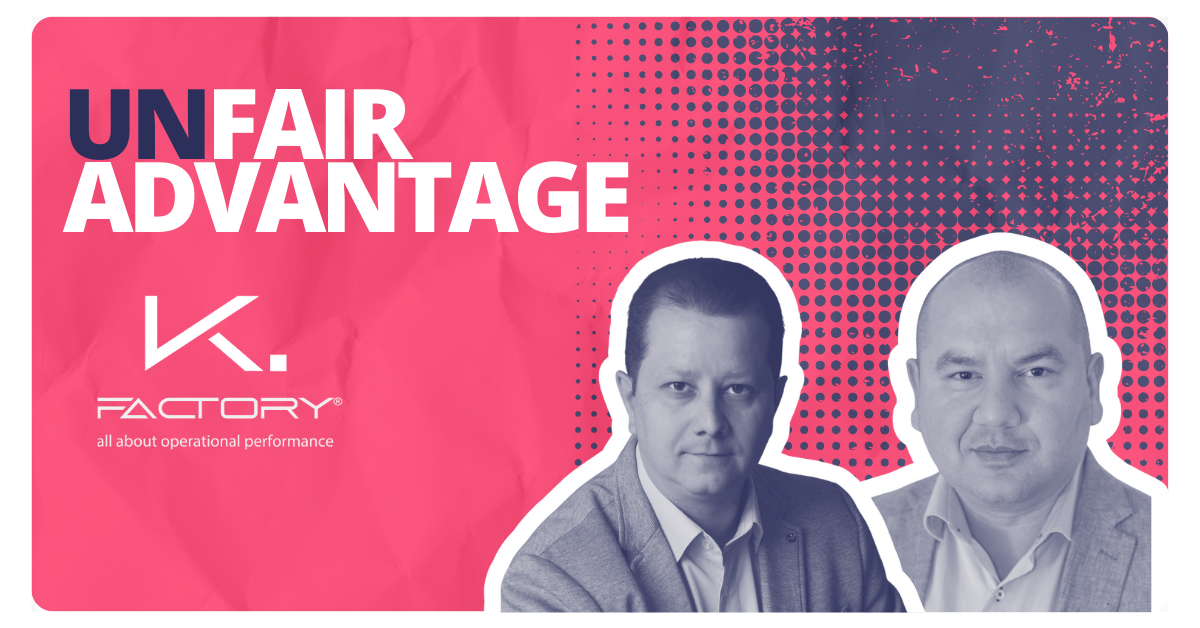Great start-ups aren’t built on marginal improvements. They’re built on asymmetric advantages—insights, technologies, or approaches that create exponential rather than linear returns. Unfair Advantage tells the stories of founders who aren’t just participating in markets, but reshaping them entirely. In this series, we dive deep into the unconventional strategies and unique insights that transformed their industries.
While Industry 4.0 promises a future of fully automated smart factories, the reality of manufacturing today remains tied to paper processes and Excel sheets. Adrian Dima and Vlad Cazan, the founders of KFactory are bridging this gap with their approach: combining deep industry expertise with AI-driven Virtual Engineers to transform traditional manufacturing operations. Their story shows how understanding the real challenges on the factory floor can lead to revolutionary solutions.
1. What’s the most contrarian belief you hold about your industry that other smart people disagree with?
A lot of people imagine manufacturing as it’s shown in movies—full of robots, AI, and futuristic automation. But the reality is far from that. Most factories still rely heavily on paper-based processes and Excel spreadsheets to manage their operations. While Industry 4.0 technologies are advancing, the real challenge is bridging the gap between this high-tech vision and the everyday manual processes that dominate the manufacturing floor.

2. What market signal made you absolutely certain this was the right time for your solution?
The strongest signal came from our deep knowledge of both the products and the market. Having been directly exposed to the manufacturing industry, we clearly saw the technology gap that many factories were struggling with. We knew firsthand that manufacturers were facing growing issues with efficiency, alongside mounting pressure from their end customers to reduce costs, meet tighter deadlines, and comply with increasingly stringent regulations. This combination of internal inefficiencies and external demands made it clear that the market was ready – and in urgent need – for a solution like ours.
3. If your biggest competitor acquired you tomorrow, what would they gain that they couldn’t build themselves?
Products in the same category may look similar on the surface, but each one is a unique blend of market knowledge, product expertise, commercial strategy, and the founders’ vision. KFactory embodies a combination of these elements that can’t simply be replicated. Our deep understanding of the manufacturing industry’s specific pain points, coupled with how we package and deliver our solution, sets us apart. We bring a perspective and approach that is uniquely ours, and we trust that our customers recognize and value these differences.
4. Tell me about a key metric that surprised you – what did you learn from it?
We were surprised by how open decision-makers in the manufacturing industry were to adopting AI-driven solutions. We initially expected it would take significant effort to convince them of the value of AI, assuming there would be skepticism or resistance to change. However, many were not only receptive but eager to embrace new technologies to improve efficiency and gain a competitive edge. This taught us that the industry is more ready for digital transformation than we initially believed, and it encouraged us to push our AI capabilities even further.

5. What will it take for your solution to become the industry standard in 5 years?
To make our solution the industry standard in five years, we’ll need to work hard and stay focused. This means constantly improving our product to meet the changing needs of manufacturers, building strong partnerships in the industry, and making sure our solution is easy to use and provides clear benefits. By doing this, we aim to become the go-to choice in the market.
6. What capability are you building now that will become your biggest competitive advantage at scale?
We are currently developing advanced AI capabilities, specifically our Virtual Engineers, which we believe will become our biggest competitive advantage as we scale. These AI agents are designed to integrate seamlessly into factory operations, providing real-time monitoring, predictive analytics, and proactive decision support. By automating routine tasks and offering intelligent insights, our Virtual Engineers empower manufacturing teams to focus on strategic activities, thereby enhancing efficiency and productivity. This unique blend of artificial intelligence and industry expertise positions us to deliver unparalleled value to our clients as we grow.

7. How has your definition of product-market fit evolved since your last funding round?
Since our last funding round, our definition of product-market fit has remained consistent. However, with recent advancements in AI, particularly our development of Virtual Engineers, we’ve enhanced our product’s capabilities. These AI-driven features have strengthened our alignment with market needs, making our solution even more valuable to our customers.
8. What convinced your first enterprise customer to take a chance on a startup?
Our enterprise customers chose to partner with us because of our team’s expertise, our ability to speak their business language, and the robustness of our product. They recognized that we understood their specific challenges and could provide a solid solution tailored to their needs.

9. Which metrics do you watch obsessively that others in your space might be ignoring?
In our approach, we don’t fixate on any metric obsessively. Instead, we apply common sense by monitoring a range of Key Performance Indicators (KPIs) across various levels of our operations. This balanced strategy allows us to identify areas for improvement and implement necessary changes on a quarterly basis, ensuring continuous progress and alignment with our goals.

